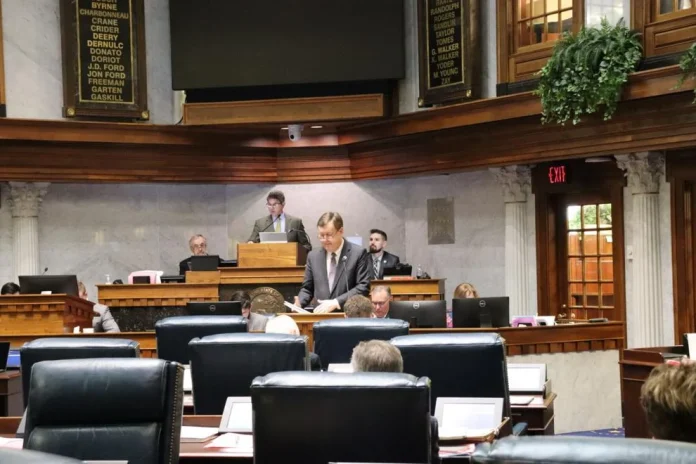State bail denial change could worsen racial incarceration, bail disparities
- By Abriana Herron, The Indiana Citizen

If the resolution becomes part of the constitution, what changes will come from it, she questioned, and how will it impact Black and brown people around the state?
“If this passes, I can’t imagine in five or 10 years how things are going to look,†Hudson said. “Workforce wise, economy wise, how does this affect people’s communities and families?â€
Legislators, organizations and members of the Black community have openly expressed concerns about SJR 1 because of its potential impact on minority Hoosiers who are already disproportionately incarcerated with higher bail amounts than white people in the state.
After SJR 1 was presented to the Senate Corrections and Criminal Law Committee Jan. 17, Sen. Greg Taylor, D-Indianapolis, who is Black, asked resolution author Sen. Eric Koch, R-Bedford, if there were any guardrails in the resolution to help prevent minorities from receiving the brunt of this constitutional change.
Koch replied that local judges and prosecutors have the skills and tools needed to make the best decisions on bail.
“When laws change, in their subjective opinions that are allowed to restrict a person’s freedom, for some reason the people that look like me end up being on the short end of the stick,†Taylor said during the meeting. “So you got to understand that I am hesitant to move in that direction.â€
Black people were jailed 4.5 times more than white people in 2019, making up 33% of Indiana’s prison population but only 9% of the state population, according to the Sentencing Project’s 2021 research on racial and ethnic disparity in state prisons.
Nationally, bail amounts are also 35% higher for Black men and 19% higher for Latino men in comparison to white men accused of similar crimes, and according to a 2022 study from Indiana University’s Center for Research on Inclusion and Social Policy, Marion County bail amounts are similar to the national average.
“I think our judicial system is jacked up,†said Anthony Beverly, director of Stop the Violence Indianapolis. “Black people get the brunt of everything and hardly anything good.â€
Stop the Violence Indianapolis is an organization geared toward ensuring safety, justice, accountability and healing for people in greater Indianapolis who are impacted by violence and poverty.
As the director of the organization, Beverly directly sees how Indiana’s bail system impacts Black young adults, especially Black men who are in the jail system.
He said in order to better the disproportionate impact on minorities, Indiana should get rid of its bail system altogether.
“They shouldn’t have to pay a dime to get out, especially on low-level offenses,†he said.
Koch declined to comment to The Indiana Citizen but, while presenting the resolution during the Jan. 17 meeting, he said the legislation was created to strengthen public safety in the state.
“The court indicated that courts should, in fact, always consider public safety when setting bail,†Koch said. “As a constitutional matter, public safety is currently not a consideration in Indiana. However, it should be.â€
As the 2023 legislative session has ended, SJR 1 advances to the next stage of becoming a constitutional amendment. It was passed in both chambers—concurred in the Senate with a 38-9 vote that fell closely along party lines. The legislation was signed by Senate President Pro Tempore Rodric Bray, R-Martinsville, and House Speaker Todd Huston, R-Fishers, and will head to the next elected General Assembly.
Mike Cunningham, an attorney in southeastern Indiana and chair of the Indiana State Bar Association’s criminal justice section, said the legislation is unnecessary because judges already consider public safety when considering bail.
The Indiana Constitution states under Article 1, Section 17 that “offenses, other than murder or treason, shall be bailable by sufficient sureties.†SJR 1 would add the language “unless the accused poses a substantial risk to any other person or the community,†as well as a “clear and convincing evidence†clause.
The Indiana Code outlining pretrial risk assessment gives judges the ability to release defendants “unless the state presents evidence relevant to a risk by the defendant of nonappearance or to the physical safety of the public.â€
“I want to stress that I think these legislators who are proposing this are well meaning,†Cunningham said in an interview with The Indiana Citizen. “I believe that they believe this is going to help, but I don’t think that we’re really getting to the meat and potatoes of it to make a real impact because we can already do that [withhold bail from defendants who pose a risk to public safety].â€
Courtney Curtis, assistant executive director of the Indiana Prosecuting Attorneys Council, said similar legislation under current law is why she is not afraid of the changes the resolution will bring.
“I will not stand before you and say, ‘I am terrified as to what the courts will do’ because in amending the state’s constitution, you are borrowing your own statute and case law wording,†Curtis said during the House Courts and Criminal Codes Committee meeting March 29.
While testifying in support of the resolution, she said the amendment is necessary because of the way the state constitution is written. For those who are worried about the changes coming, she reiterated that bail is an appealable decision and defendants are represented during bail hearings.
In order to change the state constitution, the same resolution must be adopted by two General Assemblies and then voted on in a statewide referendum. The earliest the resolution would be on the ballot is in the 2026 general election, Koch said.
What defines ‘a substantial risk’?
The Bail Project, a national nonprofit organization that assists people with paying bail, opposes SJR 1.
There has been an increase of legislation similar to SJR 1 across the country, said Erin George, The Bail Project’s national director of policy, but Indiana would be the outlier because it’s “extremely vague†and “contains almost no guardrails.â€
“What it’s doing is taking an ineffective and unjust money bail system and replacing it with an equally ineffective and unjust preventative detention scheme,†she said.
Cunningham said the vague language of the resolution concerns him as well.
“I really think it’s too broad, and we are kind of asking for trouble when we are not careful with our language,†he said.
The language doesn’t specify what a substantial risk is, leaving it up to interpretation of the judge.
It could be interpreted as a risk in terms of violence, Cunningham said, but after experiencing a global pandemic, it could also be stretched as far as saying someone is a substantial risk in terms of spreading communicable diseases.
The language used in other states’ substantial risk clauses are more specific. Ohio’s constitution states “a substantial risk of serious physical harm to any person or to the community,†specifying that a violent offender can be denied bail.
Others, like Hudson, are concerned if state judges can accurately determine if someone is “a substantial risk.â€
“There are people walking around who are a substantial risk, but they just haven’t been caught or profiled,†Hudson said. “They aren’t subject to the same level of scrutiny. So it’s just like, ‘You’re a substantial risk, how about we just go ahead and lock you up?’ It’s awful.â€
An amendment was later added to the resolution that required the state to prove “by clear and convincing evidence that no release conditions will reasonably protect the safety of any other person or the community.â€
Bail has been a topic of debate in recent years, with the legislature passing HEA 1300 in 2022. The law, which was signed by Gov. Eric Holcomb in March of that year, restricts those for whom charitable bail organizations, like The Bail Project, can pay bail.
The Bail Project is a nonprofit organization that combats mass incarceration and racial criminalization nationally and in Indiana by paying bail for people who can’t afford it while also providing other resources such as transportation to and from court.
The American Civil Liberties Union of Indiana (ACLU) and The Bail Project filed a lawsuit against the state in May 2022 claiming HEA 1300 violated the organizations first amendment rights.
While the lawsuit is ongoing, George said there is still time for Indiana to “get it right†with SJR 1 by stopping it in its tracks.
Tough on taxpayers
State taxpayers will be impacted the most by this constitutional change, Cunningham said. With more people in jail, there will be fewer taxpayers and fewer hirable people.
“Ultimately, it’s going to be tough on taxpayers because with more people in jail, without bail, you are going to need more resources,†he said.
According to the Vera Institute for Justice, 74 counties in Indiana spent $244.6 million on jails in 2019, which is an average of $3.3 million or 8.5% of each county’s total budget.
The institute also found that a 15% increase of people in Indiana jails could cost taxpayers at least $12 million.
Whether it be on minorities or state taxpayers, Hudson said this constitutional change could have lasting impacts on Indiana’s future.
“I feel like this is the case with a lot of legislation that’s passed,†she said. “ It’s like a knee-jerk reaction to something in the short term without thinking of the long-term implications.â€
What’s next for SJR 1
SJR 1 was passed in the 2023 legislative session and heads to the 2025 legislative session. George said usually “what passes in the first round is what ends up going to the ballot after the second round†when it comes to constitutional amendments.
“But I don’t think that people’s freedom should come at the expense of expediency,†she said.
The process of amending any state constitution is slow because it needs to be, George said, to protect the rights of defendants and the safety of the public. Democratic and Republican lawmakers need to work together to rethink the money bail process rather than amend the state constitution, she said.
“Wouldn’t you want a system that couldn’t send you to jail because you didn’t have enough money?†she asked. “Wouldn’t you want a system that required judges to make decisions about your liberty—which is the most fundamental of rights—in a transparent way? In a lawful way that protected due process?â€
This article was published by TheStatehouseFile.com through a partnership with The Indiana Citizen (indianacitizen.org), a nonpartisan, nonprofit platform dedicated to increasing the number of informed, engaged Hoosier citizens.
FOOTNOTE: Abriana Herron is a 2022 journalism graduate of the Indiana University Media School. She recently was a Report for America corps member and reporter at The Indianapolis Recorder. Her work for The Indiana Citizen Racial Justice Reporting Project is supported through the Herbert Simon Family Foundation.





